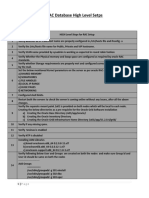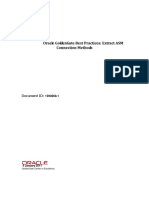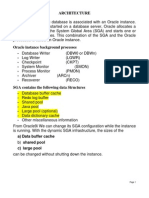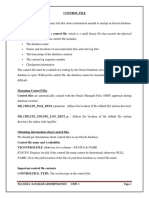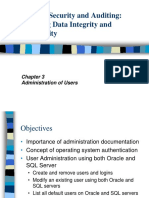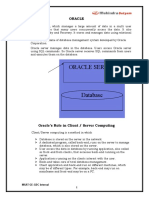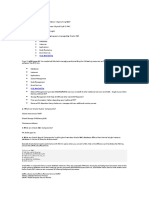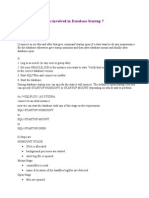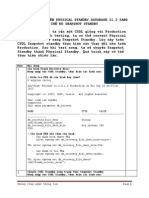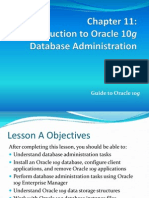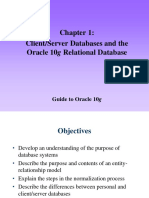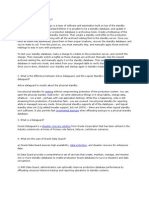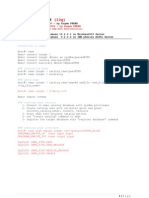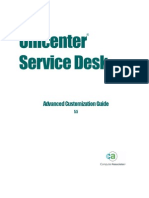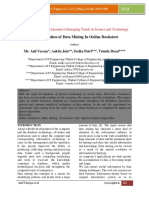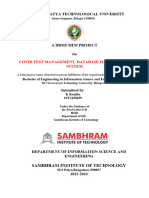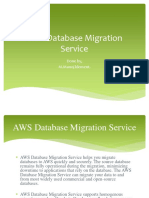Oracle 10g Database
Administrator: Implementation
and Administration
Chapter 2
Tools and Architecture
�Objectives
Identify the main DBA tools in the Oracle10g
software suite
Configure Oracle Net Services to connect to the
database
Examine Oracle database instance architecture
Examine Oracle database memory architecture
Oracle 10g Database Administrator: Implementation and Administration
�Objectives (continued)
Examine Oracle database process architecture
Examine Oracle database connection management
architecture
Start using the Enterprise Manager
Go through a brief introduction to the Database
Control
Oracle 10g Database Administrator: Implementation and Administration
�Overview of DBA Tools
Many of these tools become integrated in:
Central workspace
Enterprise Manager console
Database Control
Grid Control
Tools give you a way to work on the database
In a Windows-style environment
You must also understand how to work directly from
the command line
Oracle 10g Database Administrator: Implementation and Administration
�Overview of DBA Tools (continued)
Oracle 10g Database Administrator: Implementation and Administration
�Overview of DBA Tools (continued)
Oracle 10g Database Administrator: Implementation and Administration
�Overview of DBA Tools (continued)
Changing a users password
Using a command-line tool
See Figure 2-1
Using Security Manager
See Figure 2-2
Some tasks can be handled by more than one tool
Oracle Net Services is a common denominator for
these tools
Oracle 10g Database Administrator: Implementation and Administration
�Overview of DBA Tools (continued)
Oracle 10g Database Administrator: Implementation and Administration
�Overview of DBA Tools (continued)
Oracle 10g Database Administrator: Implementation and Administration
�Overview of DBA Tools (continued)
Oracle 10g Database Administrator: Implementation and Administration
10
�Configuring Oracle Net Services to
Connect to the Database
Nearly every time you access Oracle10g
You go through Oracle Net Services
Oracle 10g Database Administrator: Implementation and Administration
11
�Overview of Oracle Net Service
Architecture
Oracle Net Services
Made up of several subcomponents that work together
Client and server installations of Oracle Net Services
Must be configured to be synchronized to the target
database
Configuration is stored in the tnsnames.ora
Service name
Set of information used to locate and communicate
with an Oracle database
Oracle 10g Database Administrator: Implementation and Administration
12
�Overview of Oracle Net Service
Architecture (continued)
Oracle 10g Database Administrator: Implementation and Administration
13
�Overview of Oracle Net Service
Architecture (continued)
Client side can reach the server-side database
By using the service name
Combined with a valid user name and password
Bequeath protocol
Allows a direct connection to a database
On a database server computer
Without going through Oracle Net services
Without requiring a network name
Allowed only when you are logged on to the database
machine
Oracle 10g Database Administrator: Implementation and Administration
14
�Overview of Oracle Net Service
Architecture (continued)
Oracle 10g Database Administrator: Implementation and Administration
15
�Overview of Oracle Net Service
Architecture (continued)
Path of communication
Client with Oracle Net
Client with JDBC driver
Terminal with direct connection
Network naming methods
Local naming
Directory naming
Host naming
External naming
Easy connect
Oracle 10g Database Administrator: Implementation and Administration
16
�Overview of Oracle Net Service
Architecture (continued)
Oracle 10g Database Administrator: Implementation and Administration
17
�Step-By-Step Configuration of Oracle
Net Services Using Net Manager
Steps:
Start Net Manager in Windows
Expand the Local node
Expand the Service Naming node
Highlight Service Naming, and click the big green plus
sign
Oracle 10g Database Administrator: Implementation and Administration
18
�Step-By-Step Configuration of Oracle
Net Services Using Net Manager
(continued)
Oracle 10g Database Administrator: Implementation and Administration
19
�Step-By-Step Configuration of Oracle
Net Services Using Net Manager
(continued)
Oracle 10g Database Administrator: Implementation and Administration
20
�Step-By-Step Configuration of Oracle
Net Services Using Net Manager
(continued)
Oracle 10g Database Administrator: Implementation and Administration
21
�Step-By-Step Configuration of Oracle
Net Services Using Net Manager
(continued)
Steps (continued):
For the connection, select TCP/IP (Internet Protocol)
as the protocol
Type the computer name on which the database
resides in the Host Name box
Accept the default selection of Oracle8i or later
Oracle 10g Database Administrator: Implementation and Administration
22
�Step-By-Step Configuration of Oracle
Net Services Using Net Manager
(continued)
Oracle 10g Database Administrator: Implementation and Administration
23
�Step-By-Step Configuration of Oracle
Net Services Using Net Manager
(continued)
Oracle 10g Database Administrator: Implementation and Administration
24
�Step-By-Step Configuration of Oracle
Net Services Using Net Manager
(continued)
Oracle 10g Database Administrator: Implementation and Administration
25
�Step-By-Step Configuration of Oracle
Net Services Using Net Manager
(continued)
Steps (continued):
Click Test
Click Close to close the test window
Click Finish to complete the definition
Save the configuration
By selecting File/Save Network Configuration from the
menu
Close Net Manager
Oracle 10g Database Administrator: Implementation and Administration
26
�Step-By-Step Configuration of Oracle
Net Services Using Net Manager
(continued)
Oracle 10g Database Administrator: Implementation and Administration
27
�Step-By-Step Configuration of Oracle
Net Services Using Net Manager
(continued)
Oracle 10g Database Administrator: Implementation and Administration
28
�Step-By-Step Configuration of Oracle
Net Services Using Net Manager
(continued)
ORACLE_HOME and ORACLE_BASE variables
Represent registry entries in Windows
And $<named> variables in Unix or Linux
ORACLE_HOME variable
Refers to the directory where Oracle installs its
executable files
ORACLE_BASE variable
The directory upward from the ORACLE_HOME
variable
Oracle 10g Database Administrator: Implementation and Administration
29
�TNS Configuration Files
The listener.ora file
Stored on the database server
Provides configuration for how the listener process
listens over the network, for connection requests
Stored in $ORACLE_HOME/network/admin
The tnsnames.ora file
Placed onto the client machine
Allows communication between client machine and
listener on the database sever
Oracle 10g Database Administrator: Implementation and Administration
30
�Working with the Listener
Listener listens for requests made by user
connections
Process then allocates a server process
Start or stop the listener
Windows
Go to the Services window
Use the listener control utility (lsnrctl)
Listener features include:
Change queue size
Set listener logging and tracing
Oracle 10g Database Administrator: Implementation and Administration
31
�Working with the Listener (continued)
Oracle 10g Database Administrator: Implementation and Administration
32
�Working with the Listener (continued)
Creating multiple listeners
Oracle 10g Database Administrator: Implementation and Administration
33
�Working with the Listener (continued)
Loading balance between multiple listeners
You cannot use Net Manager to start and stop the
listener
Oracle 10g Database Administrator: Implementation and Administration
34
�Using the Net Configuration Assistant
Oracle 10g Database Administrator: Implementation and Administration
35
�Using SQL*Plus, SQL*Plus
Worksheet, and iSQL*Plus
Troubleshooting SQL *Plus
Configuration of the listener on the server is incorrect
Client configuration of the tnsnames.ora file is
incorrect
Validate configuration using tnsping
Execute SQL *Plus
Select Start/All Programs/Oracle .../Application
Development/SQL Plus from the menu
Execute SQL *Plus Worksheet
Select Start/Programs/Oracle/Application
Development/SQLPlus Worksheet from the menu
Oracle 10g Database Administrator: Implementation and Administration
36
�Using SQL*Plus, SQL*Plus
Worksheet, and iSQL*Plus (continued)
Oracle 10g Database Administrator: Implementation and Administration
37
�Using SQL*Plus, SQL*Plus
Worksheet, and iSQL*Plus (continued)
Oracle 10g Database Administrator: Implementation and Administration
38
�Using SQL*Plus, SQL*Plus
Worksheet, and iSQL*Plus (continued)
Oracle 10g Database Administrator: Implementation and Administration
39
�Using SQL*Plus, SQL*Plus
Worksheet, and iSQL*Plus (continued)
iSQL *Plus (Internet SQL *Plus)
Web-based version of SQL*Plus
Allows you to write queries and other SQL commands
across a network
Returning results in a Web browser
Application server is an HTTP Web server
iSQL*Plus output looks like an HTML table
Oracle 10g Database Administrator: Implementation and Administration
40
�Using SQL*Plus, SQL*Plus
Worksheet, and iSQL*Plus (continued)
Oracle 10g Database Administrator: Implementation and Administration
41
�Using SQL*Plus, SQL*Plus
Worksheet, and iSQL*Plus (continued)
Oracle 10g Database Administrator: Implementation and Administration
42
�Oracle Instance Architecture
Database instance
Runs on a database server and uses data inside the
database
Oracle instance
Part of an Oracle database executing in memory
Made up of processes and memory structures
Oracle 10g Database Administrator: Implementation and Administration
43
�Shared and Dedicated Server
Processes
After a request to connect to the database is
received
Oracle creates a user session
Then, Oracle creates a server process
Dedicated server
Every user session has its own server process
Shared server
Uses CPU and memory more efficiently
By swapping out user sessions during idle time
Oracle 10g Database Administrator: Implementation and Administration
44
�Shared and Dedicated Server
Processes (continued)
Oracle 10g Database Administrator: Implementation and Administration
45
�Shared and Dedicated Server
Processes (continued)
Oracle 10g Database Administrator: Implementation and Administration
46
�Shared and Dedicated Server
Processes (continued)
Connection
Link from the user session, through the server
session, and to the database instance
Controlled in the client-side configuration of Oracle
Net Services
In the tnsnames.ora file
Oracle 10g Database Administrator: Implementation and Administration
47
�Background Processes
Support and monitor the server processes
Handle database management tasks
To keep the database running efficiently
To help maintain fast performance
Oracle 10g Database Administrator: Implementation and Administration
48
�Background Processes (continued)
Oracle 10g Database Administrator: Implementation and Administration
49
�Memory Components
Two main sections of memory
System Global Area (SGA)
Allocated when an instance is started
Deallocated when the instance is shut down
Program Global Area (PGA)
Effectively used in session connection memory
Broken into private chunks for each server process
Oracle 10g Database Administrator: Implementation and Administration
50
�Memory Components (continued)
Oracle 10g Database Administrator: Implementation and Administration
51
�Introducing Enterprise Manager
In previous versions of Oracle
Executing the Enterprise Manager console was
complicated
Too much power was placed into the console
software
Oracle10g divides power
Between the console and the Database Control
Oracle 10g Database Administrator: Implementation and Administration
52
�Running the Enterprise Manager
Console
Steps:
Click Start/All Programs/Oracle .../Enterprise Manager
Console
Add connections to databases
Add new database service to the console
In the main window of Enterprise Manager console,
double-click the Databases folder
Click the Navigator menu, and then click Add Database
to Tree
Add selected DBs from your local tnsnames.ora file
Oracle 10g Database Administrator: Implementation and Administration
53
�Running the Enterprise Manager
Console (continued)
Oracle 10g Database Administrator: Implementation and Administration
54
�Running the Enterprise Manager
Console (continued)
Oracle 10g Database Administrator: Implementation and Administration
55
�Running the Enterprise Manager
Console (continued)
Steps (continued):
Expand the ORACLASS database node
Log on to the database as SYSTEM
Oracle 10g Database Administrator: Implementation and Administration
56
�Running the Enterprise Manager
Console (continued)
Oracle 10g Database Administrator: Implementation and Administration
57
�Viewing the Features of Enterprise
Manager
Four primary tools
Instance Manager
Monitors activities in the database
Schema Manager
Displays table structures, creates new tables, indexes,
views, and any other type of object
Security Manager
Creates new users, allocates storage resources to
users, and changes passwords
Storage Manager
Monitors storage use
Oracle 10g Database Administrator: Implementation and Administration
58
�Viewing the Features of Enterprise
Manager (continued)
Examine Instance Manager
Double-click the Instance icon
Click the Configuration icon
Click the All Initialization Parameters button
Select audit_trail, and then click Description
Click the Category column heading
Click the Cancel button to return to the main console
window
Double-click Sessions
Click SYSTEM under Sessions
Collapse the Instance Manager node
Oracle 10g Database Administrator: Implementation and Administration
59
�Viewing the Features of Enterprise
Manager (continued)
Oracle 10g Database Administrator: Implementation and Administration
60
�Viewing the Features of Enterprise
Manager (continued)
Oracle 10g Database Administrator: Implementation and Administration
61
�Viewing the Features of Enterprise
Manager (continued)
Examine Schema Manager
Double-click the Schema icon in the console
Scroll down in the left window and double-click the
SYSTEM schema
Double-click the Tables folder
Scroll down and double-click the HELP table
Click the Indexes folder below the HELP table in the
left side of the console
Right-click the HELP table
Select Show Object DDL from the pop-up menu
Click Close to return to the main console window
Oracle 10g Database Administrator: Implementation and Administration
62
�Viewing the Features of Enterprise
Manager (continued)
Oracle 10g Database Administrator: Implementation and Administration
63
�Viewing the Features of Enterprise
Manager (continued)
Oracle 10g Database Administrator: Implementation and Administration
64
�Viewing the Features of Enterprise
Manager (continued)
Oracle 10g Database Administrator: Implementation and Administration
65
�Viewing the Features of Enterprise
Manager (continued)
Examine Schema Manager (continued)
Scroll down and right-click the Views folder
Select Save List in the pop-up window
Click Cancel to return to the console window
Oracle 10g Database Administrator: Implementation and Administration
66
�Viewing the Features of Enterprise
Manager (continued)
Oracle 10g Database Administrator: Implementation and Administration
67
�Viewing the Features of Enterprise
Manager (continued)
Examine Security Manager
In the console, double-click the Security icon
Double-click the Users folder
Scroll down and select the SYSTEM user
Double-click the Roles folder
Scroll down on the left side of the console and select
the RESOURCE role
Click the System tab
Oracle 10g Database Administrator: Implementation and Administration
68
�Viewing the Features of Enterprise
Manager (continued)
Oracle 10g Database Administrator: Implementation and Administration
69
�Viewing the Features of Enterprise
Manager (continued)
Oracle 10g Database Administrator: Implementation and Administration
70
�Viewing the Features of Enterprise
Manager (continued)
Examine Storage Manager
Double-click the Storage icon on the left side of the
console
Select Tablespaces under the Storage icon
Double-click the Datafiles folder
Click the datafile with the name TEMP01.DBF
Click the Storage tab
Close the console by clicking the X in the top-right
corner of the window
Oracle 10g Database Administrator: Implementation and Administration
71
�Viewing the Features of Enterprise
Manager (continued)
Oracle 10g Database Administrator: Implementation and Administration
72
�Viewing the Features of Enterprise
Manager (continued)
Oracle 10g Database Administrator: Implementation and Administration
73
�The Database Control Interface
Get the Database Control up and running
By typing this URL into a browser:
http://2600client:1158/em
Tabs
Home
Provides general information about the database and
the Oracle installation
Oracle 10g Database Administrator: Implementation and Administration
74
�Viewing the Features of Enterprise
Manager (continued)
Oracle 10g Database Administrator: Implementation and Administration
75
�Viewing the Features of Enterprise
Manager (continued)
Oracle 10g Database Administrator: Implementation and Administration
76
�The Database Control Interface
(continued)
Tabs (continued)
Performance
Shows performance information, both good and bad
Oracle 10g Database Administrator: Implementation and Administration
77
�Viewing the Features of Enterprise
Manager (continued)
Oracle 10g Database Administrator: Implementation and Administration
78
�Viewing the Features of Enterprise
Manager (continued)
Oracle 10g Database Administrator: Implementation and Administration
79
�The Database Control Interface
(continued)
Tabs (continued)
Administration
Provides a multitude of options for administration
functionality
Maintenance
Provides comprehensive maintenance access to:
Database utilities
Backup/recovery
Deployment activities
Oracle 10g Database Administrator: Implementation and Administration
80
�Viewing the Features of Enterprise
Manager (continued)
Oracle 10g Database Administrator: Implementation and Administration
81
�Viewing the Features of Enterprise
Manager (continued)
Oracle 10g Database Administrator: Implementation and Administration
82
�Summary
Using command-line interfaces to manually execute
commands may be necessary
Oracle Net Services
Allows communication between a tool and database
Must be configured on both the client and the server
The Listener Oracle service waits to receive requests
sent to the database
Service name defines the DBs name, location, and
listening port
Use Net Manager and the Net Configuration
Assistant to configure Oracle Net Services
Oracle 10g Database Administrator: Implementation and Administration
83
�Summary (continued)
Net Manager guides you through the steps of
configuring a new service name
File tnsnames.ora stores Oracle Net Services
configuration settings on the client side
File listener.ora stores Oracle Net Services
configuration settings on the server side
Server process reads data from datafiles and places
it in the buffer cache
Dedicated server
Shared server
Oracle 10g Database Administrator: Implementation and Administration
84
�Summary (continued)
PGA stores shared connection memory allocations,
separately for each application
Managers
Instance Manager tracks database activity
Set the user and password as preferred credentials
Schema Manager provides details on schema objects
Security Manager is focused on users and privileges
Roles group privileges into related sets
Storage Manager displays information about datafiles
and tablespaces
Oracle 10g Database Administrator: Implementation and Administration
85




